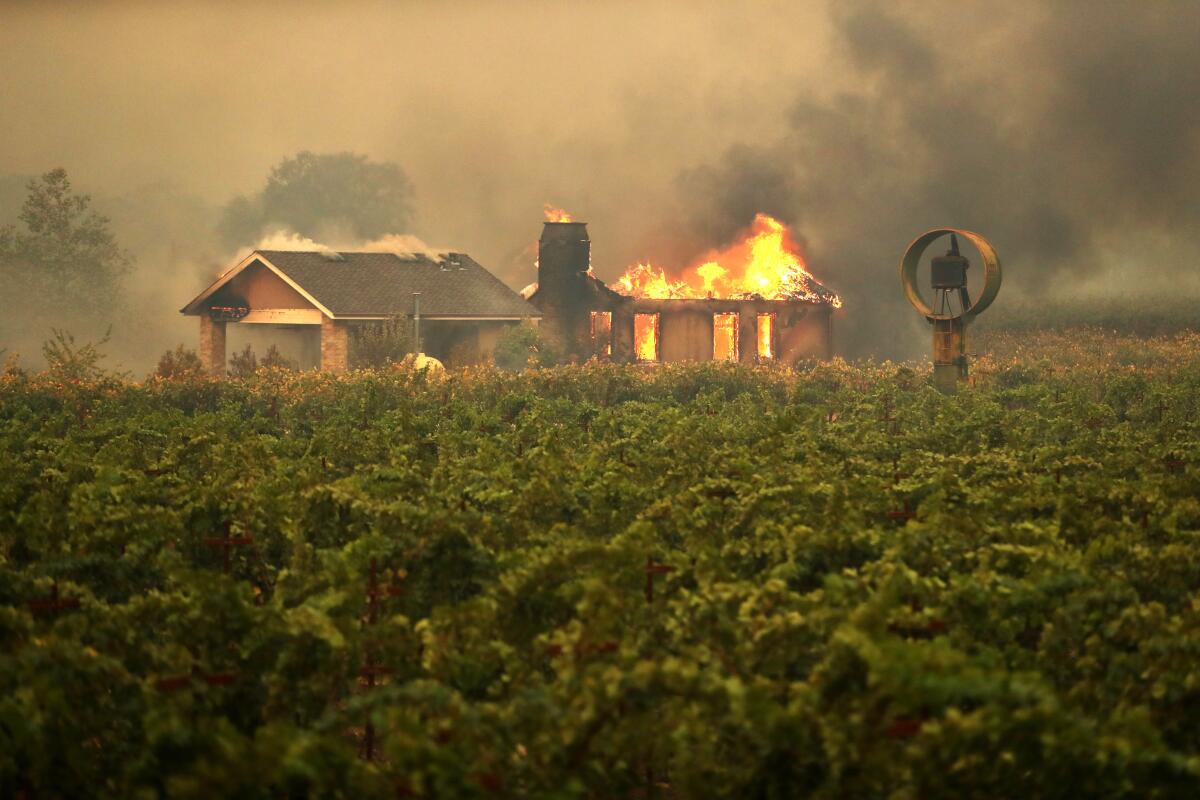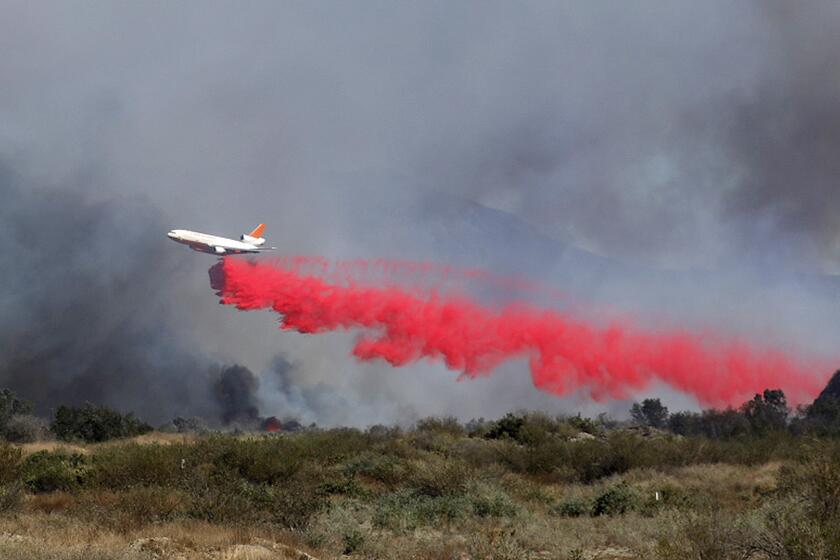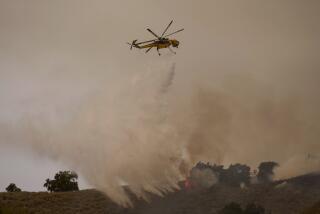California fires were bad, but they could have been much worse

The eight days of historic winds and evacuations, of unprecedented power shutdowns and explosive fires, relented Thursday with a guarded sense of relief.
Dozens of fires across the state destroyed more than 300 buildings, forced hundreds of thousands from wine country to Brentwood to flee their homes and left millions without power.
But the firestorms over the last week did not result in any fatalities, and the losses were much lower than in the last two years, when thousands of homes were lost and dozens were killed.
Officials emphasized that the fire season is far from over and that many communities remain at risk.
New fires Thursday ripped through neighborhoods in San Bernardino and Riverside County, destroying more homes.
And Ventura County firefighters are now battling the monster Maria Fire, which is threatening homes in the rural town of Somis.
But given the dangerous weather conditions, the outcome could have been much worse.
Fire officials said they learned from catastrophic fires over the last two years, and that the public did too. More resources were on hand when the fires hit, the evacuations were more extensive and more people heeded the warnings.
âThe citizens responded very effectively,â said Rich Brocchini, spokesman for the California Department of Forestry and Fire Protection. âA lot of the success lies on the shoulders of the residents by following the evacuation orders and wanting to understand the severity of what could potentially happen. When you remove people from a dangerous situation, you will have less lives affected.â
The Maria fire broke out atop South Mountain, just south of Santa Paula, about 6:14 p.m. Thursday and quickly burned toward the small agricultural towns of Somis and Saticoy.
The toll of wildfires in California has been staggering over the last two years. Much of Paradise was destroyed last year at the same time that the Woolsey fire devoured more than 1,000 homes from Oak Park to Malibu.
When the Easy fire in Simi Valley threatened the Ronald Reagan Presidential Library on Wednesday, Ventura County Fire Chief Mark Lorenzen said his department was prepared with far more aircraft and firefighters than it had when the Woolsey blaze hit. He credited the aggressive air support in the first hours of the Easy fire with preventing it from burning into subdivisions.
Mother Nature helped a bit too.
In Southern California, the expected 30 hours of wind â which garnered the first âextreme red-flag warningâ that National Weather Service forecasters can recall making â swept through, not quite living up to its forecast.
Daniel Swain, climatologist with UCLA and the National Center for Atmospheric Research, said the air pressure differential between the high desert and the coast turned out to be smaller than predicted, lessening the intensity of extreme fire weather fueled by dry air rushing toward the sea.
âThey did cause some damage, but not the widespread damage that you can see during these extreme events sometimes,â he said.
The last gusts were still whipping up chaos here and there throughout the day Thursday. A fire in the foothills of San Bernardino destroyed six homes, but firefighters had it under control by midday. Other crews beat back fires in Fullerton and Jurupa Valley.
In Simi Valley, fire crews managed to keep the larger Easy fire in place, holding their lines and keeping the blaze from running into neighborhoods.
Officials lifted all mandatory evacuation orders affecting some 26,000 residents in Simi Valley, Moorpark and Thousand Oaks.
Mike DesForges, spokesman for the Ventura County Fire Department, said crews would work throughout the day to put out hot spots still smoldering in thick brush. Strong winds were still a major concern, so strike teams were stationed in neighborhoods to keep an eye on the fire line.
âIf thereâs hot spots that break out, theyâll go in and handle that,â DesForges said.
At the height of the fire, roughly 7,000 homes were in harmâs way.
The fire had burned 1,723 acres and was 10% contained by Thursday morning.
The size of the fire pales in comparison to Ventura Countyâs previous wind-driven monsters: the Thomas fire that burned almost 282,000 acres, destroyed more than 1,000 structures and killed two people in 2017; and the Woolsey fire that started near Simi Valley last year and roared all the way to the ocean, killing three and burning 1,600 structures to the ground.
The sense of dodging a bullet was more pronounced in Northern California, which had just endured two horrific fire seasons in a row. In 2017, fires erupted throughout wine country and points north and east, killing 44 people and destroying more than 6,000 homes. The next year brought the worst fire in California history. The Camp fire tore through the wooded town of Paradise and surrounding areas, killing 86 people and destroying 14,000 homes.
With the Kincade fire burning in rural northern Sonoma County last week, officials moved to prepare for a 36-hour wind event beginning late Saturday night across the region. Pacific Gas & Electric Co. shut off power to more than 2 million people to prevent its electric lines from sparking fires. And officials took the extraordinary precaution of evacuating 200,000 people, some as far as 20 miles away in Bodega Bay on the coast.
It made for a miserable week but not a fatal one. The fact that so many people had recently witnessed catastrophic fire firsthand inevitably made it easier for officials to get them to obey evacuation orders.
With power shutdowns becoming more frequent, some Bay Area residents are mastering the art of preparation.
In Southern California, an extreme wind event began Tuesday night as high pressure rolled over the Great Basin.
Forecasters were expecting an air pressure differential between the high desert and the coast not seen in October since 2007, when howling winds fueled the Witch fire in San Diego County, torching nearly 200,000 acres and leaving two dead. That differential was a record for any October on the books, at negative 10.2 millibars, driving strong winds as high-pressure air sought a path through mountain slopes and canyons to fill lower-pressure voids on the coast.
This week, given the dry fall vegetation and low humidity, officials issued the extreme red-flag warning.
The pressure differential hit only negative 9.3 millibars, and that âmay have made the difference between a historic event [and] just a severe, strong one,â sparing California from the worst, Swain said.
Wind gusts recorded Thursday were still strong â 67 mph in a Ventura County coastal valley, the National Weather Service reported, not much weaker than a peak recorded Wednesday of 78 mph at Boney Peak in the Santa Monica Mountains.
The winds should decrease by Friday.
âLuckily, we are not seeing any more Santa Ana winds within the next week,â Phillips said.
But in a sign of the danger that could still loom, forecasters donât see any rain ahead for the next few weeks, either.
Times staff writers Joe Mozingo, Hannah Fry, Colleen Shalby and Alex Wigglesworth contributed to this report.
More to Read
Sign up for Essential California
The most important California stories and recommendations in your inbox every morning.
You may occasionally receive promotional content from the Los Angeles Times.
















